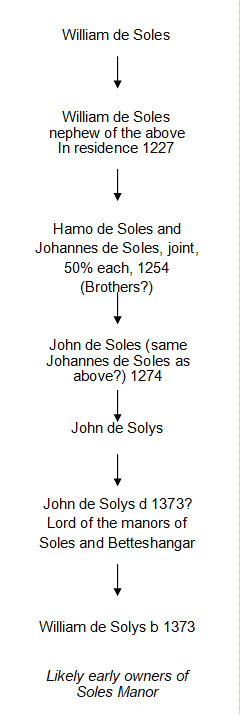By George Solly
This article was published in the April 2023 edition of Soul Search, the Journal of The Sole Society
In 1864, Planché in his book, A Corner of Kent (p401) writes:
This ancient family (Solly), of which so many descendants are resident in the parish (Ash-next-Sandwich) at the present day (1864), is presumed to have taken its name from the manor of Soles, in the neighbouring parish of Nonnington, in Wingham hundred, part of the possessions in 1080 of Odo, Bishop of Baieux. A John de Soles was in the possession of it in the reign of Edward I (1272-1307) and his descendant, another John died, seized of it in 1376. It was alienated (transferred to another person/sold) in 1400 or 1401.
In 1972 I visited Soles Court Farm and found it to be derelict. I picked up an old stoneware water bottle found on site, possibly Victorian, now lost.
Latest research from:
www.nonington.org.uk/solys-now-soles-court states: “Soles Court Farm is located near the hamlet of Frogham on the southern edge of the parish of Nonington. It is one of the oldest settlement sites in Nonington and was recorded as a separate manor in Domesday Book of 1086. The old Soles farmhouse, probably dated from the late 17th century, but was abandoned in the late 1950s and fell into a state of disrepair and was demolished in the 1980s, now just a few outbuildings remain.
Soles, originally Solys, derives from the Old English ‘sol’, meaning mud or mire, which in Kentish dialect could mean a pond or pool of muddy water or a muddy, boggy area. Sole is a very common Kentish place name, for example Broadsole at Frogham, near Soles Court Farm.
Domesday Book recorded:
Ansfrid holds Soles from the bishop It answers for one sulung. Land for… In lordship 2 ploughs; 8 villagers with ½ plough. Value before 1066, 100 shillings; later 20 shillings; now £ 6. Aelmer held it from King Edward.
The bishop referred to above is Odo, Bishop of Dover and Bayeaux and Earl of Kent, half-brother of William I with whom he later fell out with and who stripped Odo of his lands and titles.
Soles Manor was the site of a very early mill which is mentioned in a fine of 1227. This finalised: a protracted legal dispute between William de Soles and Cecily de Dovre, the daughter of Agnes by John Le Archer, over ownership of the single knight’s fee of Soles. See box below for explanation of a Knight’s fee. The fine refers to a capital messuage [the then manor house and outbuildings which would have been on or near the site of the later manor house] and the half site of a mill previously held by William’s uncle, also William de Soles. The windmill was likely to the north-east of the manor house on the same site as the later Barfreston mills.
The farm was so named because it held a ‘Court Baron’. These were introduced into the 1090s feudal system and became responsible for the regulation of local matters. The court dealt with such matters as the transfer of land; the organisation of the common fields and meadows; the abatement of nuisances for example defective hedges, blocking of paths, straying beasts, etc). The Steward, ran the court for the lord, and looked after the lord’s rights, including rentals, heriots and boon work.
Other references to Sole Court Farm:
In 1254: a roll of holders of knight’s fees recorded that in the “Hundred of Eastry. Hamo de Soles tenet dimid feod in Soles de Ricardo Rokesle – nota bene Johanes de Soles tenet dimid in eodem de eodem”, which translates as: “Hamo de Soles holds half of Soles from Richard Rokesle (Richard de Rokestle), Johanes de Soles holds half in the same place on the same terms”.
In 1274-75: On returning from crusade in 1274 King Edward I ordered the making of the Kent Hundred rolls [1274-75] which recorded the rights and dues owed to him. The Hundred of Eastry entry for Soles reads: “Then they say that John de Soles holds one fee in Soles of John de Rokeste and the same John of Robert de Crevequer and the same Robert of the king in chief and he owes 20s. each year at Dover Castle”.
In 1375: On 28th December, 1375, King Edward III granted to Geofrey Chaucer, King’s Esquire, and author of The Canterbury Tales, the guardianship and the right of marriage of William de Solys, a minor then aged one year and heir of the late John de Solys, lord of the manor of Soles and Betteshanger. Awarding a guardianship was commonly done for royal favourites and members of the royal household: ‘the guardian became responsible for maintaining the heir in a manner appropriate to his estate and for keeping the property from deterioration’. The land at Soles was worth five ‘solidates’, a solidate was as much land as was worth one shilling (five pence) a year.
In 1528: 19th Henry VIII: Thomas Norton sold to John Boyes, ¼ of the manor of Soles [the manorial rents and fees], with 200 acres of land, 200 acres of pasture and 60 acres of woodland in Nonington and Barfreston for £40.”
If indeed Soles Court Farm was the origin of Soles in Kent, then from the above information and that of William Hasted in his ‘History and Topographical Survey of the County of Kent’ vol. IX, published in 1800 we might surmise the ownership of the manor by Sollys to be as on previous page.
By the ‘4th year of Henry IV’s reign’ (ca. 1403) there were no more de Solys at Soles Manor.
Simon Solly (1408—1466) is the furthest back Solly on the societies’ charts and the exciting possibility is that he might be the son or grandson of William de Solys (born c. 1373 )whose guardian was Geoffrey Chaucer!
All this is conjecture but might nevertheless help explain the origin of Kentish Sollys!

